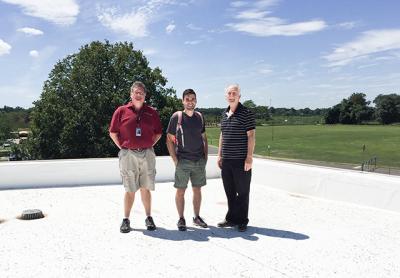Weather Station Coming?

East Hampton High School’s cool roof may get cooler, man.
The reflective rooftop surface already helps control the building’s interior temperature by deflecting sunlight, and the school district has plans to install solar panels up there, too. The rooftop may soon also be home to a high-tech weather detection station. East Hampton is being evaluated by the State University at Albany as one of 17 sites around the state to receive enhanced weather equipment as part of the New York State Early Warning Weather Detection System, also known as the New York Statewide Mesonet.
“Once implemented, this advanced weather observation network will improve the accuracy and reliability of weather prediction, especially during extreme weather events,” Jerald Brotzge, Mesonet’s program director, said in announcing the plan last month. “We also anticipate that these weather stations will provide a broad array of community benefits including new educational, research, and discovery opportunities and better weather forecasts for local residents.”
East Hampton school officials are looking forward to the potential installation, which, they said this week, would open up a world of research possibilities for students and community members.
“Usually we’re saying, ‘How can we get to Cold Spring Harbor [Laboratory]? How can we get to Brookhaven [Laboratory]?’ We’d have it here,” Robert Tymann, the assistant superintendent, said during Tuesday’s school board meeting.
The weather equipment requires a space measuring 20 by 20 feet, capable of holding 500 pounds. Administrators of the Mesonet program are also reportedly considering the Emergency Services Building in East Hampton Village as the recipient.
School District officials said the high school rooftop could easily accommodate the equipment. While it requires electricity and ethernet, the state will pay those costs, so nothing will come out of taxpayers’ pockets.
The enhanced weather station setup includes a light detection and ranging sensor, known as a LiDAR, which emits short pulses of laser light into the atmosphere and measures their scattering in order to observe radial wind speed and other variables. The station also includes a microwave radiometer, which collects data on temperature, humidity, and cloud profiles, and a sun photometer, which tracks the path of the sun during the day to measure its direct radiance.
